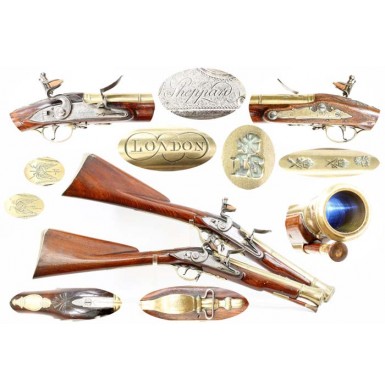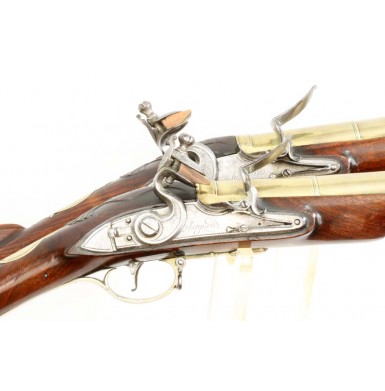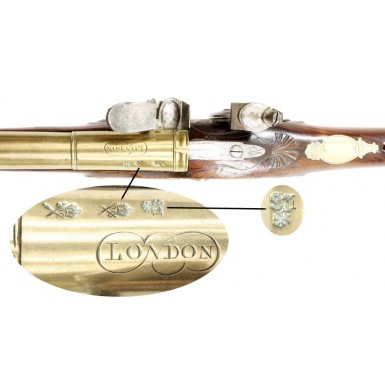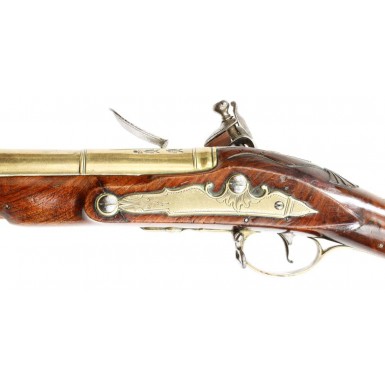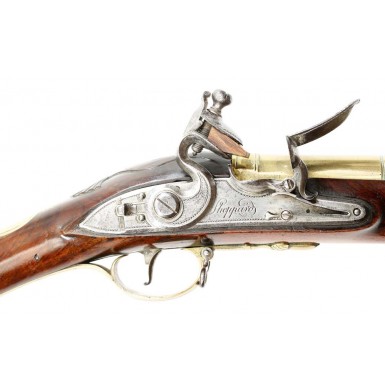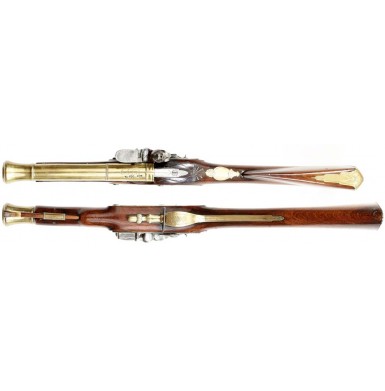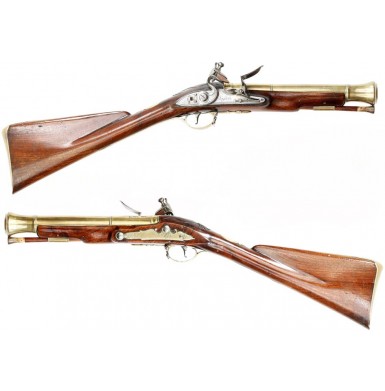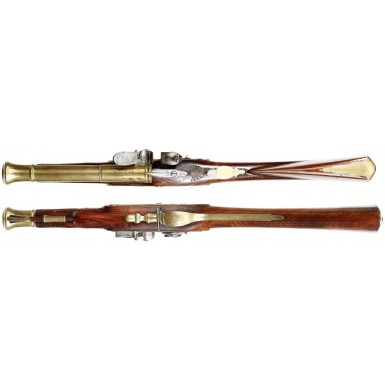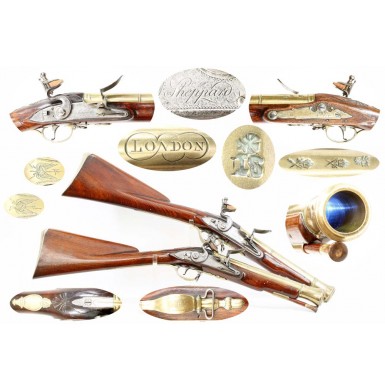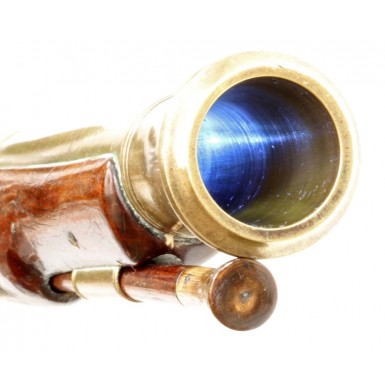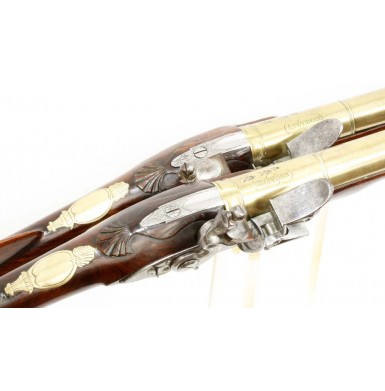Extremely Rare Matched Pair of Flintlock Coaching Carbines
- Product Code: FLA-3273-SOLD
- Availability: Out Of Stock
-
$1.00
The word blunderbuss often suggests the dramatically flared muzzle firearms found in romanticized paintings of the Pilgrims at the Frist Thanksgiving, and more recently in the cartoonish images of Pilgrims (and even turkeys) armed with these somewhat exaggerated weapons. In reality, the “blunderbuss’ appears to be a weapon that originated in the Low Countries (Netherlands) around the middle of the 17th century and which spread rather quickly to England, where it became a popular weapon for self-defense and protection of ones, home, property and mode of transportation. By definition, a blunderbuss is a short barreled long arm with a flared muzzle that was designed to spray its shot in a relatively wide pattern at close range, making it particularly effective for deterring would be assailants that were in close proximity, and relying a minimum of skill or aiming to be relatively effective. The term “blunderbuss’ is the anglicized version of the Dutch / German term Donner Busse or Donder Busche meaning “thunder pipe” or “thunder gun”. These guns were, for all practical purposes, the first “tactical shotguns’ and had minimal use for sporting applications as their short barrels and wide, flared muzzles were not intended for use beyond 20 to 30 yards. The form evolved rather quickly in England, where the blunderbuss would remain a stapled defensive weapon of the coachman for nearly a century and half. Only the advent of the percussion era and the nearly simultaneous spread of early railroads brought the day of the coach gun to an end in England. For much of the period during which the blunderbuss was produced in Great Britain the basic form was a flintlock muzzleloader with a bore between about .60” and 1” and a widely flared muzzle. Early guns tended to have iron barrels, but by the early 1700s most the guns were made with brass barrels, with iron only coming back into general use in the first quarter of the 1800s, during the waning days of the blunderbuss. Early guns tended to be somewhat clunky and bulky, with simple furniture and dog lock batteries; functionality being the primary concern over aesthetics. During the first quarter of the 1700s, the form matured and more graceful lines and ornamentation became typical. The blunderbuss reached its aesthetic apex during the latter half of the 18th century, when engraved locks and furniture became more common and enhancements like triggerguard finials and wrist escutcheon plates became common. Raised carved aprons around the barrel tang became common embellishments as well. Barrels were often multi-stage during the 18th century, with octagon-to-round forms appearing and the use of baluster turned “wedding bands’ between various stages of the barrels. A new form of blunderbuss started to emerge during the mid-1700s, the “coaching musketoon” or “coaching carbine”. These guns tended to have less profoundly flared barrels and were intended to give a longer effective range to the shot than the more radically flared muzzle of the traditional blunderbuss. I some cases the barrels were longer than the typical blunderbuss as well, again in an attempt to increase the effective range of the weapon. During this period canon shaped muzzles became popular on these “carbines’ and the addition of spring deployed “snap bayonets’ became popular as well. A miniaturized version of the coaching carbine (sometimes referred to as a “bedroom blunderbuss’ by collectors) was also popularized during the period as an easier to handle, more compact weapon (along the lines of a sawed-off shotgun) that could be easily concealed by an overcoat, but could be wielded handily within the confines of a room or even the interior of a coach or carriage. These weapons could be as small as about two foot in length with barrels of only about ten inches.
The need for such weapons was due to the very danger inherent in travel across England during the latter 17th and most of the 18th century. Roads were limited of poor quality and rarely maintained, with the exception of privately owned coach roads and turnpikes that required a traveler to pay a toll for their use. Footpads and Highwaymen abounded and travelers were often accosted and robbed while travelling in the country side. It was for that reason that people rarely traveled alone and even the mail coaches and stage coaches of the period usually relied upon a crew of at least two, a driver and guard. The guard often doubled as the baggage handler and had to help free coach when it was stuck or to repair damage that was often caused by the rough roads. These men inevitably relied upon some form of blunderbuss (or a pair if available) as their primary weapon for defending the coach, its passengers and any freight or mail it might be carrying.
Offered here are a really wonderful matched pair of Miniature Coaching Carbines by John Sheppard of London, probably made circa 1770-1780. The guns are from the zenith of blunderbuss and coaching carbine production and are a wonderful example of the high quality of craftsmanship as well as artisanship that went into a high-end self-defense weapon of the period. The guns remain in VERY FINE condition and are extremely attractive. The locks of the guns are engraved Sheppard in a lovely period script and were it not for the touch mark on the barrel, it would be difficult to know exactly which “Sheppard” was the gun maker, as several men with that surname worked as gunsmiths in London during the period. In this case the touch mark of an asterisk over IS indicates John Sheppard (the “I” being an archaic “J”) was the maker. John Sheppard worked in the Rotherhithe district of the south-eastern London borough of Southwark. Howard Blackmore’s A Dictionary of London Gunmakers 1350-1850 shows him working during the period of 1766 to 1784, with an address of 349 Rotherhithe during the latter part of his career. The tops of both barrels are also engraved LONDON, and are both marked with a wonderful pair of London commercial view and proof marks. All of the markings remain crisp and sharp throughout the guns.
The guns are quite small and measure only about 25” in overall length with 10 1/8” long barrels. The brass barrels are round, three-stage affairs with slightly flared canon muzzles. The barrels have iron tangs and ““ wide grooved breeches with sighting notch in the tang and breech. Forward of a pair of baluster turned rings is a 2 ““ chamber area, followed by more baluster turned rings and a slightly smaller diameter barrel section that measures 5” in length. This terminates in more baluster turned rings and a 2” long, slightly flared canon shaped muzzle. The muzzles measure about 1 ““ at the exit and bores appear to be nominally about .90” for most of the length of the barrels. The barrels are secured to the stocks with a single pin in the forends and via a single screw through the breech tangs. Both barrels show crisp, undisturbed touchholes which show no indication of erosion or even moderate wear. The bores of the guns are in fine, smooth condition with some dark debris and dirt in the chambers that could be swabbed out. The brass barrels have been cleaned in the European fashion and are starting to dull down from the high polish they likely received some 40 of 50 years ago. The barrels have a lovely medium golden patina that should turn to a nice butterscotch hue in the coming years. The barrels are smooth and show no pitting or erosion. A thin line of greenish residue is visible along the barrels at the point where the metal and wood meet. This is not the dark green typical of verdigris, but is likely the residue from an old polishing of the barrels. The iron breech tangs have been polished as well, leaving the lightly engraved enhancements slightly worn, and the tang screw heads are engraved with a petal motif to match that of the tangs. The beveled iron locks have a semi-waterproof, integral round iron pans and a sliding safeties that lock the hammer in the half-cock position, preventing them from being cocked or lowered. The hammers are beveled, flat, swan neck cocks with slightly exaggerated cockscombs at their tops. The edges of the locks and hammer bodies have simple chiseled boarder engraving that is expertly executed. Both locks are unmarked on their interiors, except for file slash mating marks, one showing the mark | | and the other showing | | | |. Both locks are mechanically EXCELLENT and function perfectly, crisply locking into both the full and half cock notches. The sliding safeties both work perfectly, securely locking the hammers in place when at half-cock, and the frizzen springs remain quite stiff and fully functional. All lock parts appear to be original including the both the main and frizzen springs on both locks, as well as the cocks, top jaws and top jaw screws. Both cocks hold a piece of wood, carved to resemble a flint in their jaws. The guns are in original, unaltered flintlock condition and remain completely original in this respect. The frizzens both show some scuffing and wear, but the guns show little indication of heavy firing. The locks have been cleaned in the European fashion and have a silvery gray tone to them with lightly scattered darker surface discoloration from oxidation. The locks show evenly distributed pinpricking as well as some light pitting on their surfaces. The guns are mounted with brass furniture including the buttplate, side plate, wrist escutcheon triggerguard and rammer pipe. Like the barrels, this brass has been cleaned and polished at some point in the last 40 or 50 years and is starting to tone down. The buttplates are engraved on their tops with martial standards, flags drums and panoplies of arms. Interestingly the engravings are not quite identical, with one showing draped flags, a drum and a pair of crossed muskets with bayonets (one facing up and one facing down) and the other showing the same basic scene with the exception that the two muskets are facing down and a halberd has been added in the middle. The flat side plates are lightly engraved with chiseled boarders that match the locks and hammers, but with additional feather slays around the holes that the side nails (lock screws) pass. A third, smaller screw, secures the side plates to the stock flats. The triggerguards have long tangs to help support the delicate wrists of the guns, and these tangs show the same chiseled boarder patterns as found on the other metal of the gun, terminating in feathered splays that match the side plates. The forward portion of the triggerguards terminate in nicely rendered acorn finials and the triggerguard bows are engraved with roses. The “acorn and rose” motif is a commonly encountered theme on the triggerguards of English blunderbusses from this period. Both triggerguards have small iron sling swivels mounted in their bows, indicating that although these miniature coaching carbines are dainty and attractive, they were intended to be carried and used. Both swivels appear to be original. Lovely brass escutcheons are mounted in the wrists of the guns. They are large ovals with shell shaped sprays at the tops and urn shaped bases. The escutcheons are executed in a rococo form, and although the centers could be engraved with owner’s initials or coat of arms, they remain blank. The single ramrod pipes on each gun are simple brass tubes with lightly turned decorative rings at each end. These pipes each retain an associated horn tipped wooden ram rod with iron ball screw at the opposite end. Both rods are 9 ““ in length with 2 1/16” long twisted iron wipers at the ends. The only difference is that one has a 1 7/16” long horn tip and the other has a 1 1/16” long horn tip. The two rods are nearly identical with this one exception and both may be original the guns at the fit perfectly and certainly match the condition and appearance of the guns. As the tips are slightly different, one may be a replacement. It is simply impossible to tell, but both rammers are original to the period and are absolutely perfect for the guns. The stocks of the two guns are in about FINE condition as well. The stocks are nicely embellished with raised carved aprons around the breech and tang of the barrel with a fan-shaped shell motif that is similar to the top portion of the wrist escutcheon that opposes the apron. The stocks are crisp and show no signs of sanding. Both stocks are solid and free of any breaks, cracks or repairs that I have been able to find. Both retain much of what appears to be a thinly applied varnish, and both are extremely attractive. One stock (the gun in the pictures with the hammer down) is in better than fine condition, showing only some minor bumps and dings from handling, along with some minor scuffs and light surface mars. The other gun (shown in the pictures with the hammer cocked) shows two minor slivers missing from the forend near the muzzle (one on each side), a tiny, old chip missing to the upper rear of the lock, and some very minor surface scuffing near the upper rear of the obverse butt at the buttplate. Otherwise this stock shows only the minor dings and handling marks noted on the first gun.
Overall these two guns are a really outstanding matched pair of Miniature Coaching Carbines by a fine London maker from the last quarter of the 18th century. These guns are really in wonderful condition, showing only the most minor wear from handling and storage over the centuries. Both guns appear to be 100% complete, correct and original, with the possible exception of the ram rods and it would probably be impossible to determine their originality. However, both rods are nearly identical, fit perfectly and match the guns so well that they almost assuredly original to them. Matched pairs of guns from this period are very scarce and a matched pair of miniature coaching “blunderbusses’ is something that is very rarely encountered. This pair of guns are really striking and absolutely gorgeous, displaying wonderfully and have outstanding eye appeal. It will likely be a very long time before you have the opportunity to own another matched pair of blunderbusses this fine, that are nearly 250 years old, and from the period of the American Revolution. This pair belongs in an extremely advanced collection of museum quality historic arms, and are worthy of being a centerpiece in such a collection.
SOLDTags: Extremely, Rare, Matched, Pair, of, Flintlock, Coaching, Carbines

